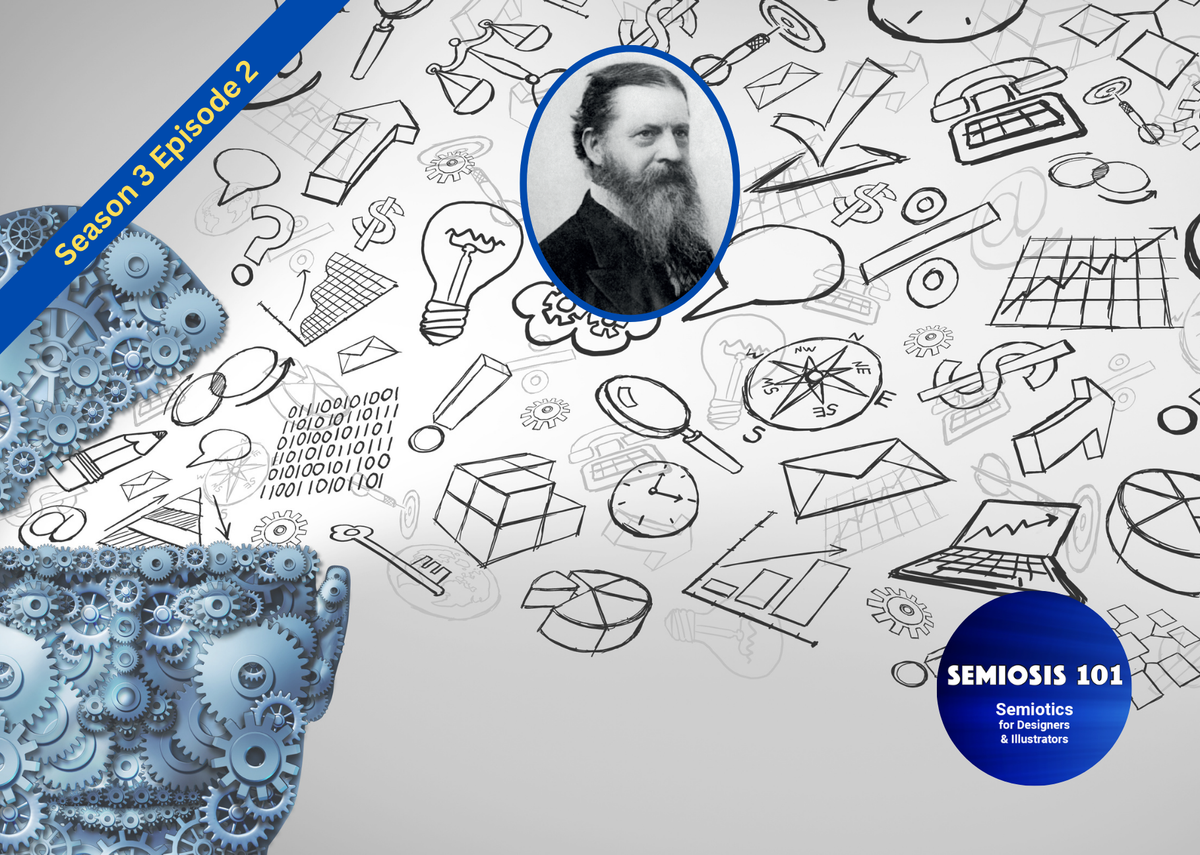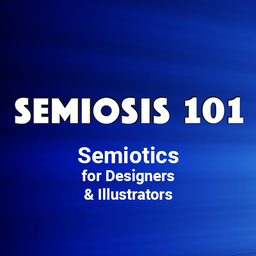Free Semiosis 101 Transcript 3.2:

IMMEDIATELY VISUALLY ENCODING MEANING: Semiotic Meaning-bearing 1
Hello readers.
In this free transcript for the episode published on Semiosis 101 on 25 October 2023, we will dig deeper into the basic level of semiotic sign-action, in order to understand how to semiotically encode. We will focus on the immediate effect a semiotic sign has on its interpretation, in a state of Firstness.
Watch the free episode on YouTube for the full impact…
…and here is the episode’s transcript.
Last week I introduced the Peircean definition of how semiotic interpretation is made at the immediate, dynamic and final levels.This week we will only focus on the immediate effect a semiotic sign has on its interpretation, in a state of Firstness. In this episode, in order to understand how to semiotically encode, we will dig deeper into the basic level of semiotic sign-action.
Hit subscribe to this YouTube channel, and I will explain…
Interpretation needs experience, existing situated cultural knowledge, and mediation in a form that is …interpretable. Wait, is that not circular thinking? interpretation needs to be interpretable?
Think about this. Quickly.
What does your nation’s flag look like? The colours, lines, shapes, etc. that form your nation’s flag can be interpreted as signifying only your nation, yes? How do you know that? You culturally learn it.
The flag Symbolises your relationship to your country’s identity. The flag also Symbolises other cultural interpretations, some personal and some collective. Which came first? Your identity built on your individual and collective experience of existing within your nation state, or the bit of coloured cloth?
We have already established that human’s will interpret meaning in practically anything, if they perceive the visual entity to be meaning-bearing. Hence, semiotic signs. The Danish semiotician Thorkild Thellefsen attributes to Peirce’s triadic structuring of Semiosis a human level of existence.
In seasons one and two we have focused on the Iconic, Indexical and Symbolic representations of a concept to be visually communicated. Thellefsen argues that this level of semiotic representation “correspond[s] to humankind.” It is a very human level of semiotic communication. That is why in the last season I spent time on how to understand the designer or illustrator’s target audience.
The audience’s lived experiences offer insights into how to craft your semiotic encoding of intended meaning to them. Now, as we turn our attention to interpretation, Thellefsen argues that this level of the effect of the semiotic representation of the sign on the interpreter (the target audience) “correspond[s] to culture.”
Peirce states that, “nothing is a [semiotic] sign until it is INTERPRETED as a sign.” Until the visual entity (or entities) that have been designed or illustrated are PERCEIVED as something. At the perception level, we are within what Peirce calls the phenomenological level of Firstness. We have already seen that this is the perceptible level that semiotic Iconic representation operates at. A level of possibilities, resemblances, familiarity. A level of perception that hooks the interpreter to wonder, “what does this mean to me?”
If the semiotic sign is not perceived as something more than it first appears, then it will not function as a semiotic sign. For this to happen the visual entity (whatever it is) has to spring recognition in the target audience as something they already know. This is the immediate effect of interpretation.
This immediate effect on the interpreter, by placing a possible impression of meaning into their mind through how the intended concept is visually represented. Peirce’s refers to this as Rhematical, (but more on this later this season). The immediate effect on the interpretation puts a possibility in the interpreter’s mind that THIS could be THAT.
Once the interpreter - the target audience - begins to interpret a thing for something then how this interpretation is visually mediated can dynamically take over (we will deal with the dynamic state next week). At the immediate effect level, Peirce says this happens as a “propositional function” (CP2.95), as a semiotic trigger to propose THIS could be THAT.
This immediate state is not tangible, but an essence of possible interpretation that needs further attention and mediated Interpretation to the “meaning of the Sign” (CP4.536). Within the immediate state, the target audience is on a cusp of perception. Either what they see has the meaning-bearing semiotic interpretable potential of being perceived, or it does not and is passed over. This is a phenomenological state of being that Peirce calls Firstness.
We have understood that the Iconic level of semiotic sign-action of representing the intended concept, is a potential aesthetic trigger to hook audience attention. This is due to the nature that Firtsness is a state of possibilities, resemblances, familiarities, potentialities and proposals. The crafting of the visual meaning-bearing entity (or entities) by a designer or illustrator as Iconic representations of familiar things in the form of lines, shapes, marks, colours, etc. is only a third of the sign-action’s power.
The immediate state of the effect on interpreting informs semiotic encoding too. Before I explain how both the Iconic and immediate levels power the sign-action, I quickly need to provide you all with a bit more theoretical context. So bear with me as I begin to conclude this episode.
In just the same way as the semiotic representation of the concept is tiered in three ascending levels of representative power (Iconic, Indexical and Symbolic); the effect of how an encoded semiotic sign has on the interpreter is also tiered in three levels of complexity as Rhemes, Dicents and Arguments.
The final third of this sign-action power is how the semiotic sign’s articulation of the meaning-bearing is represented as Qualisigns, Sinsigns and Legisigns. (We will not cover these terms in detail until season four, but they will be name-checked sporadically in later season three episodes).
The immediate effect of the choice of how the Iconic basic visual communication building blocks are composed, creates a continuing semiosis between the concept > representation > interpretation. Let me quickly explain this semiotic encoding power with a favourite Semiosis 101 visual example.
A panda.
Well a drawing of a panda.
Or a drawing of a bear.
Or a drawing of an animal…
or just a pattern of shapes…
or just black blobs…
or just black.
In season two I used an example of a panda to illustrate how the Iconic, Indexical and Symbolic levels of representing a concept work. (Check out season two’s second omnibus to catch up). This time we will return to the panda drawing to consider the semiotic effect of interpreting the panda from the illustration. We will stay in a state of Firstness.
If you look at this drawing and see a panda…
Well done. You win.
If you looked at this drawing and saw a bear.
Well done, but not accurate enough.
If you looked at this drawing and saw an animal.
Well done, but no reward.
If you only see shapes and patterns.
Well done.
If you only see black blobs.
Yup.
If you only see black. er… yup!
None of these interpretations are incorrect are they? All six of these interpretations are accurate and come from the same drawing. Six interpretations that are correct? Yes. Let me reorder them in a perceptual order…
Black > Blobs > Shapes > Patterns > Animal > Bear > Panda
The first four of these are perceived in a state of Firstness. We perceive black blobs forming shapes, and those shapes forming a pattern. We see the “black” and the “blobs” but do we interpret these as anything that is meaning-bearing? When we perceive the “black blobs” are shapes, we begin (because we are hard-wired to) to see if they form a pattern. Whether there is a meaning-bearing intent in any patterns we see, we still need to interpret. There may not be - it could just be spilt black ink. (I am not testing to see if any of you are psychopaths, honest!) But if looking at these shapes a pattern is perceived you cannot help interpreting what it COULD be.
You have just been made aware of the immediate effect on how we semiotically interpret. As this IS a drawing of a panda, we can see the illustrator has used the black shapes as Iconic representations of key areas of a panda’s body. In this panda example, we see how the immediate effect on interpretation is intrinsically linked with Iconic representation.
The patterns are Iconic visual communication building blocks which hook attention to trigger interpretation. How far along the intended semiotic sign-action path toward the concept of “panda” the interpreter can proceed, is dictated by the interpreter’s lived experience and learnt cultural references. (If the interpreter has never culturally seen “a panda” in their lived experience, they will never interpret that!)
At this stage the interpreter has only got as far as perceiving a “pattern.” This pattern may be semiotically encoded as meaning-bearing. The immediate effect offers only a possibility of a semiotically encoded animal, bear or even a panda! Come back next week when we move from the immediate effect on semiotic interpretation up to Secondness and the dynamic state.
Semiosis 101 Semiotic Design Resources is a reader-supported publication. To receive exclusive posts and support my work, consider becoming a free or paid subscriber. Paid subscribers get name checked on all future Semiosis 101 YouTube episodes.
===Semiosis 101 Patreon Producer==============
Become a Semiosis 101 Patreon Producer and get a named producer credit on future video episodes, plus watch all new episodes months ahead of YouTube.
===Semiosis 101 Patreon Exclusives==============
Watch longer Patreon-exclusive Semiosis 101 episodes on applying Semiosis into design and illustration…
PATEXC001 How does semiotics work in illustration?





